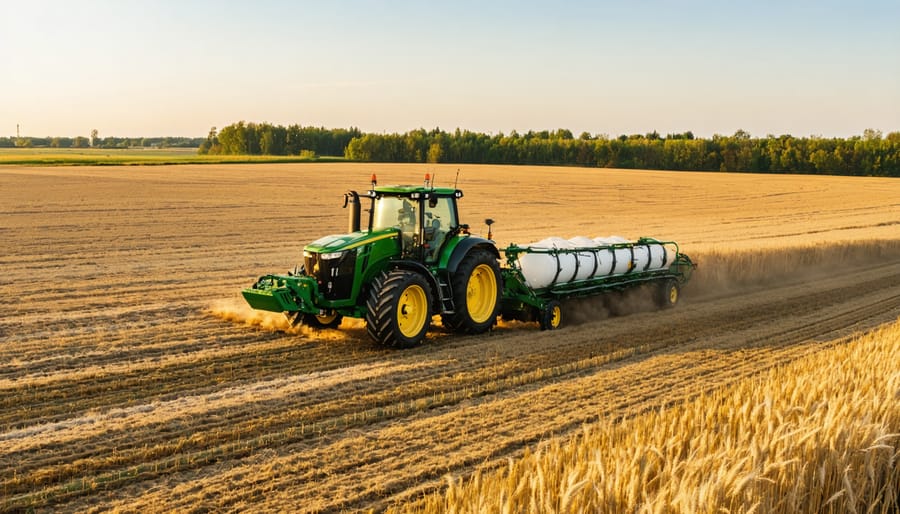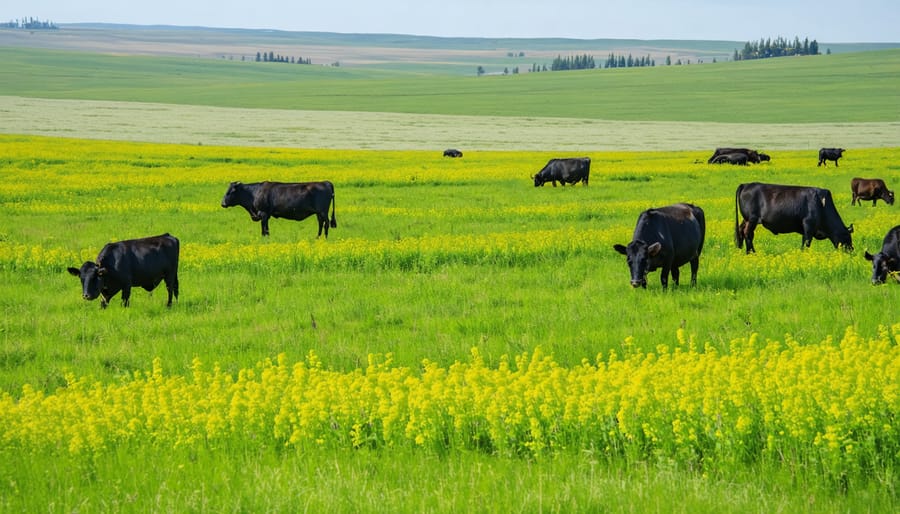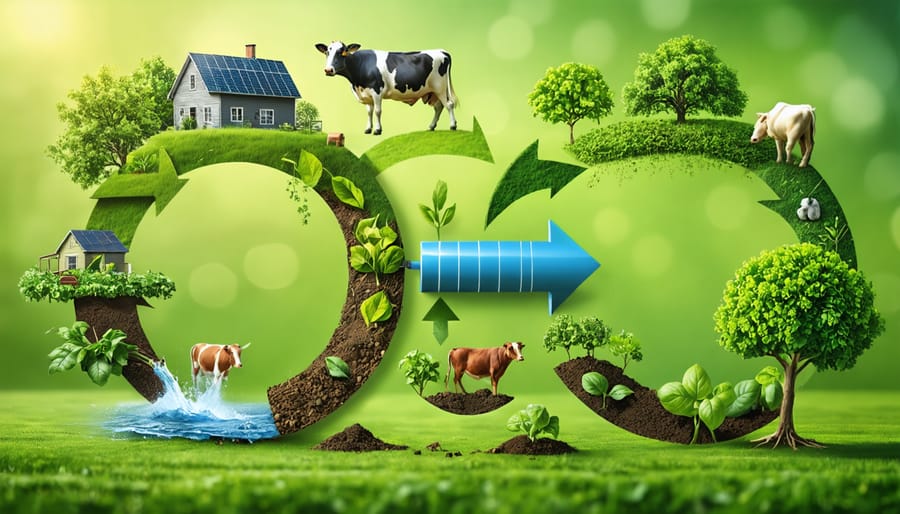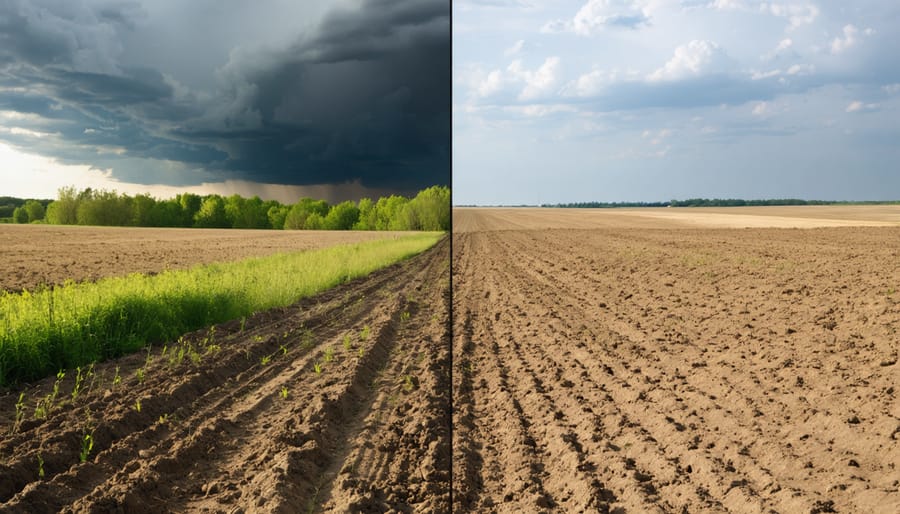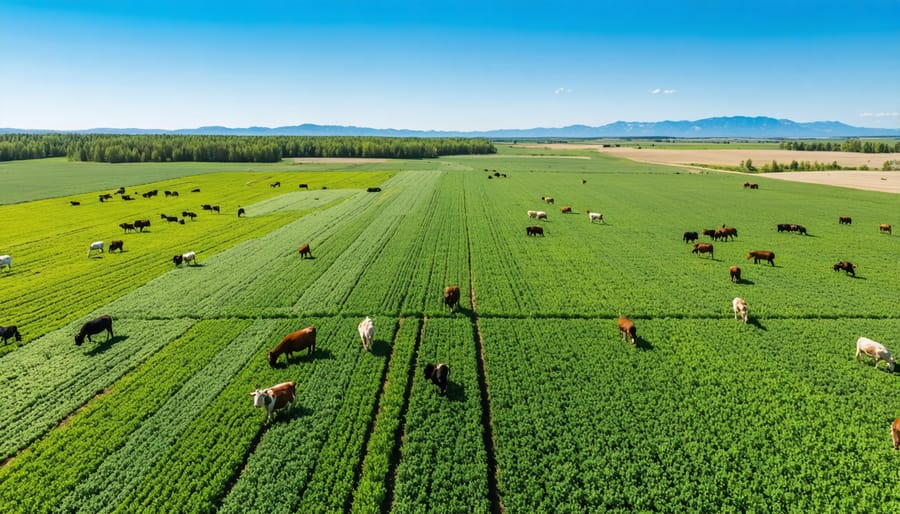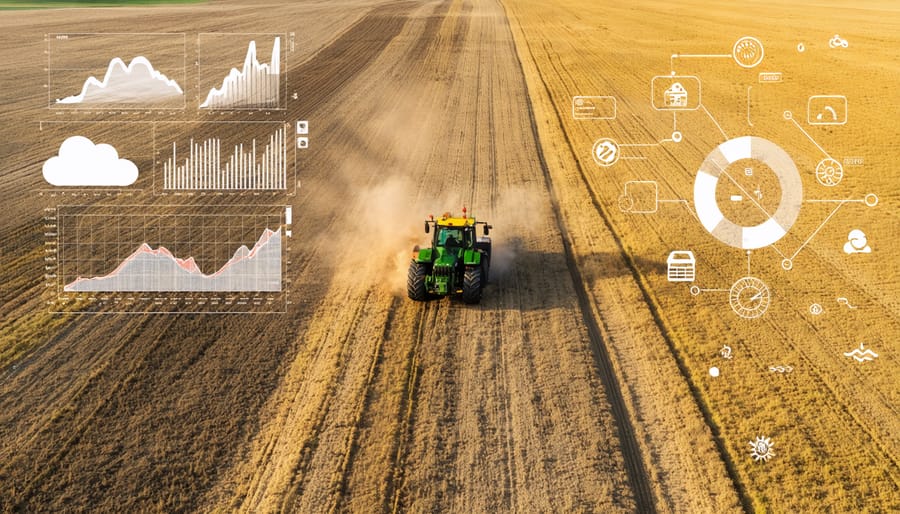Water scarcity threatens global food security and agricultural sustainability, demanding immediate action from farmers and agricultural stakeholders across Canada. In Alberta alone, irrigation systems consume over 60% of the province’s water withdrawals, highlighting the critical need for innovative water management solutions. Through advanced monitoring technologies, precision irrigation techniques, and regenerative farming practices, producers can reduce water consumption by 30-40% while maintaining or improving crop yields.
Leading Alberta farmers have already demonstrated remarkable success by implementing sustainable water management strategies. The combination of soil moisture sensors, weather-based irrigation scheduling, and drought-resistant crop varieties has helped these operations cut water usage by 2.5 million cubic meters annually. These water-saving practices not only preserve our vital resources but also deliver substantial economic benefits, with participating farms reporting average cost reductions of $75-100 per hectare.
Our agricultural future depends on transforming how we view and manage water resources. By adopting sustainable water management practices today, Canadian farmers can build resilient operations that thrive in an increasingly water-stressed world while setting new standards for environmental stewardship in agriculture.
Water-Smart Technology That’s Transforming Alberta Farms
Precision Irrigation Systems
Modern precision agriculture technology has revolutionized how Alberta farmers manage water resources. Smart irrigation systems, equipped with soil moisture sensors and weather monitoring tools, help producers deliver exactly the right amount of water at the right time.
These systems typically include soil probes that measure moisture content at various depths, providing real-time data through smartphone apps. For example, Ben Thompson, a third-generation farmer near Lethbridge, reduced his water usage by 30% after installing moisture sensors across his 800-hectare operation.
Weather stations integrated with irrigation controllers automatically adjust watering schedules based on local conditions. These systems consider factors like temperature, humidity, wind speed, and precipitation forecasts to optimize irrigation timing. Some advanced setups even incorporate satellite imagery to detect crop stress and adjust water distribution accordingly.
Variable-rate irrigation technology allows for precise water application across different zones within a field. This means sandy areas can receive more frequent, lighter applications, while clay-rich zones get less frequent, deeper watering. Many Alberta farmers report water savings of 15-25% while maintaining or improving crop yields.
The initial investment in these systems is often offset within 2-3 growing seasons through reduced water and energy costs. Government programs through the Canadian Agricultural Partnership can help offset implementation costs, making these solutions more accessible to local producers.
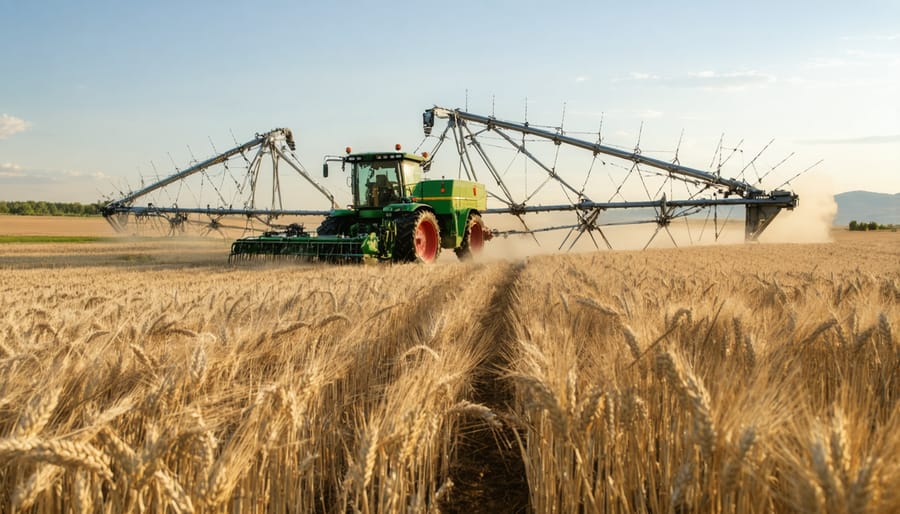
Digital Water Management Tools
Modern technology has revolutionized how Alberta farmers manage their water resources, offering precise control and data-driven decisions through digital tools. Leading the way are soil moisture monitoring systems that provide real-time data directly to smartphones, helping farmers make informed irrigation decisions.
Popular apps like IrrigationScheduler and FieldConnect have gained traction among local farmers, offering user-friendly interfaces that integrate weather forecasts, soil moisture levels, and crop water requirements. These tools can reduce water usage by up to 30% while maintaining or improving yields.
Cloud-based platforms are particularly valuable for larger operations, allowing farmers to monitor multiple fields simultaneously and share data with team members. For instance, the Alberta-developed WaterTrack system helps farmers create detailed irrigation schedules based on historical data and current conditions.
Smart meters and flow sensors connected to mobile apps provide instant alerts about system malfunctions or unusual water usage patterns, preventing waste and potential crop damage. Many of these tools can be integrated with existing irrigation systems, making adoption straightforward and cost-effective.
Local agricultural extension offices offer training sessions on these digital tools, and many manufacturers provide free trials, allowing farmers to test different options before making an investment. The initial cost is often offset by water savings within the first growing season.
Soil Health: Your Secret Weapon for Water Conservation
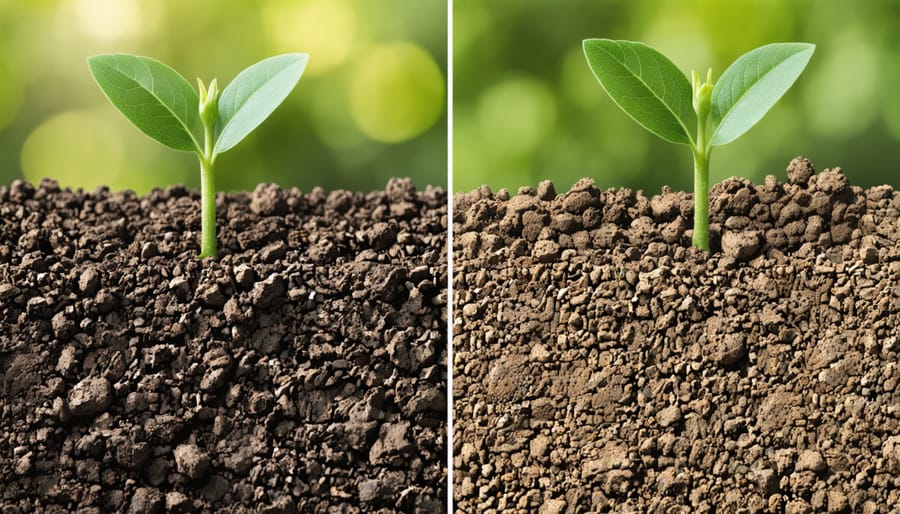
Building Water-Holding Capacity
Building your soil’s water-holding capacity is a cornerstone of sustainable water management, and it starts with implementing proven soil regeneration practices. Here in Alberta, we’ve seen remarkable results when farmers focus on improving their soil structure and organic matter content.
Start by incorporating cover crops like clover or rye between main growing seasons. These plants create a protective layer that reduces water evaporation while their roots improve soil structure. Many Alberta farmers have found success with cocktail cover crops, mixing multiple species to maximize benefits.
Adding organic matter through composting and crop residue management is equally crucial. For every 1% increase in organic matter, soil can retain an additional 25,000 litres of water per hectare. Local farmer Mike Thompson from Lacombe County reports that after three years of implementing these practices, his fields now require 30% less irrigation.
Consider these practical steps:
– Minimize tillage to preserve soil structure
– Apply well-aged compost in spring or fall
– Maintain crop residue on fields
– Rotate crops to improve root diversity
– Use mulch to reduce evaporation
Soil testing is essential to track progress. The Alberta Agriculture Soil Testing Laboratory recommends annual testing to monitor organic matter levels and adjust management practices accordingly. Remember that building water-holding capacity is a gradual process – most farmers see significant improvements within 3-5 years of consistent implementation.
For best results, combine these soil-building strategies with efficient irrigation systems and careful timing of water application. This integrated approach helps create resilient farming operations that can better withstand both drought and heavy rainfall events.
Cover Cropping Strategies
Cover crops are proving to be a game-changer for Alberta farmers looking to optimize water usage while improving soil health. These strategic plantings, particularly during shoulder seasons, help manage soil moisture levels and reduce irrigation needs for primary crops.
Many Alberta farmers have found success with cold-hardy varieties like fall rye and winter wheat, which establish quickly and provide excellent ground cover through our challenging prairie winters. These crops create a protective blanket that reduces water evaporation and prevents soil erosion during spring melt.
Local farmer Mike Thompson from Lethbridge County reports a 30% reduction in irrigation needs after implementing a three-year cover cropping rotation. “We’ve noticed that our soil holds moisture better, and our main crops are more resilient during dry spells,” he shares.
Key benefits for water management include:
– Enhanced soil structure that improves water infiltration
– Reduced surface evaporation through ground coverage
– Increased organic matter that boosts water retention
– Prevention of soil crusting and runoff
For best results, consider timing your cover crop planting to coincide with natural precipitation patterns. Many Alberta farmers seed their cover crops immediately after harvest, taking advantage of fall moisture. Remember to terminate cover crops at the right time to preserve soil moisture for your main crop.
When selecting cover crops, focus on species that establish quickly and provide maximum ground coverage while using minimal water themselves. Legumes like field peas and clovers can be particularly beneficial, offering both soil protection and nitrogen-fixing benefits.
Water Recycling Success Stories from Alberta’s Fields
Grey Water Systems
Implementing grey water systems on Alberta farms represents a significant step toward circular farming practices and water conservation. These systems capture and filter water from sinks, showers, and laundry facilities, making it safe for agricultural use. On average, a properly designed grey water system can help farmers reduce their freshwater consumption by 30-50%.
Several Alberta farmers have successfully integrated grey water systems into their operations. The Morrison Family Farm near Lacombe, for example, installed a bio-filtered grey water system that now supplies water for their greenhouse operations and livestock washing facilities, saving approximately 250,000 litres of water annually.
To implement a grey water system, farmers typically need:
– A collection system for capturing used water
– A filtration unit (often utilizing natural bio-filtration)
– Storage tanks with proper insulation for winter months
– Distribution infrastructure for agricultural use
Local regulations permit grey water use for irrigation of non-food crops, greenhouse operations, and general cleaning. The initial investment ranges from $5,000 to $15,000, depending on system size and complexity, with most farmers reporting a return on investment within 3-5 years through reduced water costs and increased operational efficiency.
Remember to consult with local agricultural extension offices and water management experts when planning your system to ensure compliance with regional guidelines and maximize effectiveness for your specific farming operation.
Rainwater Harvesting
In Alberta’s variable climate, rainwater harvesting offers farmers a reliable way to capture and store precipitation for agricultural use. A well-designed system typically includes roof catchments, storage tanks, and distribution infrastructure, allowing farmers to collect thousands of litres during heavy rainfall events and spring snowmelt.
For example, the Thompson family farm near Red Deer installed a 50,000-litre storage system in 2021, reducing their reliance on groundwater by 40% during the growing season. Their setup includes food-grade polyethylene tanks and a simple first-flush diverter to ensure water quality.
To maximize collection efficiency, consider installing gutters with leaf guards and positioning storage tanks where they can capture runoff from multiple farm buildings. Underground tanks work well in our climate, as they prevent freezing during winter months and maintain cooler temperatures in summer. Many Alberta farmers combine these systems with gravity-fed irrigation, reducing energy costs while ensuring consistent crop hydration.
When planning your system, factor in annual precipitation patterns and crop water requirements. A typical quarter section in central Alberta can collect approximately 600,000 litres annually from roof surfaces alone. Local agricultural extension offices can help calculate optimal storage capacity based on your specific needs.
Remember to check municipal regulations regarding water collection and storage. Many regions offer grants and technical support for implementing rainwater harvesting systems as part of sustainable farming initiatives.
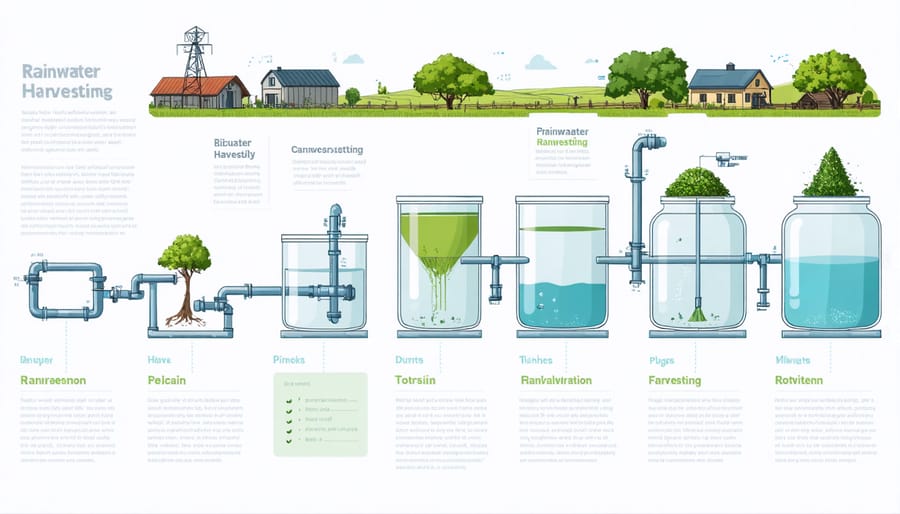
Making Water Management Work for Your Budget
Government Programs and Incentives
Several government programs and financial incentives are available to help Alberta farmers implement sustainable water management practices. The Canadian Agricultural Partnership (CAP) offers cost-sharing opportunities for irrigation system upgrades, with funding covering up to 50% of eligible expenses. Through the Environmental Stewardship and Climate Change Producer Program, farmers can access grants ranging from $5,000 to $100,000 for water-efficient technology implementation.
The Alberta Irrigation Efficiency Program provides support specifically for converting less efficient irrigation systems to low-pressure pivots or drip irrigation, offering rebates of up to $15,000 per project. Local watershed stewardship groups also facilitate smaller grants for water quality improvement projects and riparian area protection.
The Agricultural Water Management Program assists with water source development, including dugout construction and well drilling, covering up to 30% of project costs. For innovative water conservation projects, the Canadian Agricultural Clean Technology Program offers funding up to $2 million for larger-scale implementations.
Remember to contact your local agricultural fieldman or AFSC representative for application assistance and deadline information. Many programs require pre-approval and have specific environmental assessment requirements, so early planning is essential for successful funding applications.
Return on Investment Analysis
A recent study of Alberta farms implementing sustainable water management practices shows an average return on investment within 2-3 growing seasons. For example, farmers who invested in precision irrigation systems reported water savings of 30-40% and reduced energy costs by $75-100 per hectare annually.
Southern Alberta farmer Mike Thompson shares, “After installing soil moisture sensors and upgrading to drip irrigation, we’ve cut our water usage by 35% and seen a 20% increase in crop yields. The initial investment of $45,000 paid for itself in just two seasons.”
The financial benefits extend beyond direct water savings. Farms implementing these strategies report reduced fertilizer costs due to better nutrient retention, decreased soil erosion repair expenses, and lower equipment maintenance costs. Additional revenue streams often emerge through improved crop quality and consistency.
Consider these proven returns:
– Smart irrigation systems: $200-300/hectare annual savings
– Soil moisture monitoring: 15-25% reduction in water costs
– Water recycling systems: 40% decrease in annual water expenses
– Cover cropping: $150-200/hectare savings in soil amendment costs
Government grants and environmental stewardship programs can offset initial implementation costs by up to 50%, making the transition to sustainable water management more accessible for Alberta farmers.
As we’ve explored throughout this guide, sustainable water management is not just an environmental imperative but a practical necessity for Alberta’s agricultural future. By implementing efficient irrigation systems, adopting soil moisture monitoring technologies, and maintaining healthy soil structure, farmers across our region are already proving that conservation and productivity can work hand in hand.
Remember that small changes can lead to significant impacts. Start by conducting a water audit of your current operations, then implement one or two strategies that best fit your farm’s specific needs. Whether it’s switching to drip irrigation, incorporating cover crops, or installing soil moisture sensors, each step moves us toward more sustainable practices.
The success stories from fellow Alberta farmers demonstrate that these methods not only conserve water but can also improve crop yields and reduce operational costs. Local agricultural extension offices and farmer networks are valuable resources for guidance and support as you transition to more sustainable practices.
Looking ahead, our agricultural community’s commitment to responsible water management will help ensure the longevity of our farming operations while protecting this precious resource for future generations. By working together, sharing knowledge, and embracing innovative solutions, we can build a more resilient and sustainable agricultural sector in Alberta.
Take action today by reaching out to your local agricultural advisor or connecting with neighbouring farms that have successfully implemented these practices. Your journey toward sustainable water management is an investment in both your farm’s future and our shared environmental heritage.


